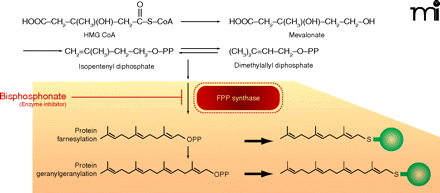
- Institution: Stanford Univ Med Ctr Lane Med Lib/Periodical Dept/Rm L109
- Sign In as Member / Individual
Bisphosphonate Therapeutics in Bone Disease: The Hard and Soft Data on Osteoclast Inhibition

Figure 3
Biochemical mechanism of nitrogen-containing bisphosphonates in osteoclast inactivation. The mevalonate pathway supports sterol and isoprenoid lipid synthesis as well as the posttranslational isoprenylation of proteins (indicated as green spheres). Nitrogen-containing bisphosphonates bind to FPPS, thereby inhibiting enzymatic activity (red blunt arrow). FPPS inhibition thus prevents the subsequent posttranslational modification (isoprenylation) of multiple small GTP-binding proteins (Rab, Rac, and Rho) central to osteoclast function, ultimately leading to osteoclast apoptosis.


